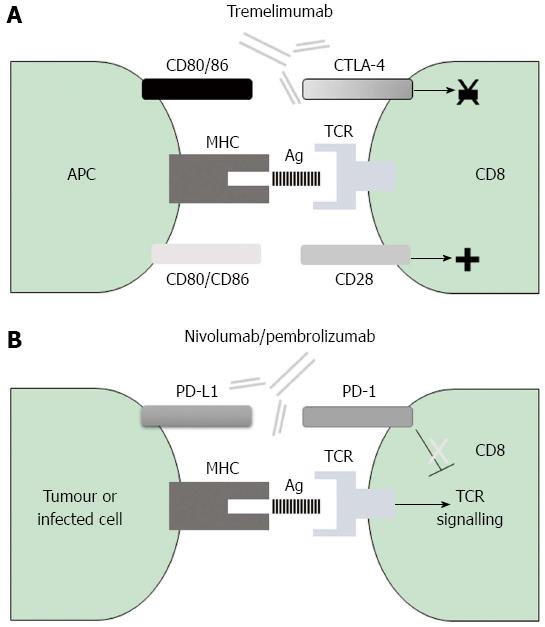Copyright
©The Author(s) 2016.
World J Gastroenterol. Jul 28, 2016; 22(28): 6469-6483
Published online Jul 28, 2016. doi: 10.3748/wjg.v22.i28.6469
Published online Jul 28, 2016. doi: 10.3748/wjg.v22.i28.6469
Figure 2 Mechanisms of action of negative co-stimulatory pathways involved in current immunotherapy for cytotoxic T cells.
A: The CTLA-4 immune checkpoint impairs early T cell activation; the inhibitory CTLA-4 molecule binds with higher affinity to the CD80/CD86 ligands on antigen presenting cells and prevents their binding to the positive co-stimulatory molecule CD28, with the consequence being a decrease in T cell activation. B: The PD-1 negative receptor on T cells interacts with either PD-L1 or PD-L2 on the surface of the infected or tumoural cell, thereby promoting T cell exhaustion; blockade of either CTLA-4 or PD-1 with humanized monoclonal antibodies releases the break that is exerted by these molecules and results in T cell activation. CTLA-4: Cytotoxic T-lymphocyte antigen-4; MHC: Major histocompatibility complex; PD-1: Programmed cell death protein-1; TCR: T cell receptor.
- Citation: Moreno-Cubero E, Larrubia JR. Specific CD8+ T cell response immunotherapy for hepatocellular carcinoma and viral hepatitis. World J Gastroenterol 2016; 22(28): 6469-6483
- URL: https://www.wjgnet.com/1007-9327/full/v22/i28/6469.htm
- DOI: https://dx.doi.org/10.3748/wjg.v22.i28.6469









